The Brazilian Série B Championship: A Comprehensive Overview of Brazil’s Second Tier
The Brazilian Série B Championship, officially known as Brasileirão Série B Superbet due to sponsorship, is the second division of Brazil’s football league system. This championship plays a pivotal role in the national football landscape, providing a platform for clubs to compete for promotion to the elite Série A while striving to avoid relegation to Série C. With a rich history, intense rivalries, and unforgettable moments, Série B is more than just a step below the top tier; it is a stage of passion, talent, and determination. This article delves into the structure, history, impact, and curiosities of the Brasileirão Série B, exploring the heart of Brazilian football.
What is the Brasileirão Série B?
The Brasileirão Série B is the second tier of professional football in Brazil, organized by the Brazilian Football Confederation (CBF). Established in 1971, the competition features 20 clubs from various regions of the country, competing annually for the title and promotion to Série A. Additionally, the bottom four teams are relegated to Série C, making each edition of the championship highly competitive.
Série B is renowned for its competitiveness and unpredictability. Traditional clubs that once shone in Série A often find themselves in the second division, fighting to reclaim their place in the elite. Meanwhile, lesser-known teams have the chance to surprise and earn a prominent spot in the national spotlight.
Structure of the Championship
The Brasileirão Série B is played in a round-robin format, with 20 clubs facing each other in home and away matches, totaling 38 rounds. Each team plays every other team twice, once at home and once away. The scoring system follows the international standard:
- Win: 3 points
- Draw: 1 point
- Loss: 0 points
At the end of the 38 rounds, the top four teams earn promotion to Série A for the following year, while the bottom four are relegated to Série C. The club with the most points is crowned the Série B champion.
Season and Calendar
The Brasileirão Série B season typically runs from April or May to November, aligning with the Brazilian football calendar. Matches are primarily played on weekends, with some games held midweek, especially in the final rounds when the competition reaches its peak of excitement.
History of the Brasileirão Série B
The Brazilian Série B Championship was created in 1971, initially as the Taça de Prata (Silver Cup), to organize Brazilian football into clear divisions. Since then, the competition has undergone numerous changes in format, number of participants, and promotion/relegation criteria.
Early Years
In the 1970s, Série B consisted of clubs that did not qualify for Série A, with the number of participants varying significantly. The competition was less structured than today, featuring group stages and knockout rounds. Clubs like Vila Nova (GO) and Londrina (PR) were among the first champions, marking the start of a journey of growth for regional teams.
Evolution and Consolidation
In the 1980s, Série B gained greater relevance, with traditional clubs like Coritiba, Atlético Paranaense, and Sport Recife competing during challenging times. From the 2000s onward, with the adoption of the round-robin format in 2006, the competition became more competitive and predictable, attracting increased attention from the media and fans.
Historic Clubs in Série B
Over the years, Série B has been a stage for major Brazilian clubs that, for various reasons, found themselves in the second division. Teams like Corinthians (2008), Palmeiras (2003 and 2013), Vasco da Gama (2009, 2014, and 2016), and Botafogo (2015) have competed in the championship, bringing significant visibility to the competition. These moments marked stories of resilience, with fans packing stadiums to support their teams in their quest to return to the elite.
Importance of Série B in Brazilian Football
Série B plays a fundamental role in the Brazilian football ecosystem. Beyond serving as a bridge between the lower divisions and the elite, it has significant economic, social, and cultural impacts.
Promotion and Relegation: The Dream and the Drama
The prospect of promotion to Série A is the greatest incentive for Série B clubs. Promotion not only elevates a club’s status but also brings financial benefits, such as higher television revenue, sponsorships, and ticket sales. Conversely, relegation to Série C poses financial and emotional challenges, particularly for clubs with large fanbases.
Talent Development
Série B is a showcase for young players and coaches. Clubs with smaller budgets often rely on youth academy players or lesser-known signings, enabling the discovery of new talent. Players like Gabriel Barbosa (Gabigol) and Neymar have passed through clubs that competed in Série B before becoming global stars.
Fan Engagement
Série B is known for the passion of its fans. Stadiums like Rei Pelé (Maceió), Couto Pereira (Curitiba), and Santa Cruz (Recife) frequently draw large crowds, even for second-division matches. The dedication of supporters creates a unique atmosphere, with chants, flags, and energy that rivals Série A.
Clubs and Rivalries in Série B
Série B brings together clubs from all regions of Brazil, creating a mosaic of cultures and rivalries. Some of the most frequent participants include Criciúma, Paysandu, Ceará, Vila Nova, and Náutico, each with rich histories and passionate fanbases.
Regional Rivalries
Regional rivalries are a highlight of Série B. Matches like Ceará vs. Fortaleza, Náutico vs. Santa Cruz, and Goiás vs. Vila Nova draw massive crowds and generate immense anticipation. These clashes often transcend the competition, carrying decades of history and rivalry.
Traditional vs. Emerging Clubs
Série B is also a battleground between traditional giants and emerging teams. While powerhouses like Cruzeiro and Grêmio occasionally appear in the competition, smaller clubs like Brusque and Novorizontino have shown the ability to compete on equal footing, challenging the hierarchy of Brazilian football.
Curiosities about the Brasileirão Série B
- Most Successful Club: No single club dominates Série B history, but teams like Goiás, Coritiba, and Atlético Mineiro have won the title multiple times.
- Attendance Record: Matches involving clubs with large fanbases, such as Corinthians in 2008, have recorded crowds exceeding 40,000 spectators.
- Historic Top Scorers: Série B has produced notable goal scorers, such as Túlio Maravilha, who scored 27 goals for Goiás in 1994.
- Sponsorship Impact: The Superbet sponsorship has increased the competition’s visibility, with investments in marketing and broadcasting.
Challenges and Future of Série B
Despite its relevance, Série B faces challenges, such as financial disparities between clubs and inadequate infrastructure in some stadiums. Additionally, the concentration of resources in Série A often limits the second division’s growth potential.
Future Perspectives
In the coming years, the CBF aims to strengthen Série B through:
- Improved Broadcasting: Expanding television and streaming coverage to reach more fans.
- Financial Incentives: Creating more balanced revenue shares for clubs, reducing the gap with Série A.
- Digital Engagement: Investing in social media and digital platforms to attract younger audiences.
The Role of Superbet
The recent Superbet sponsorship has brought a new dynamic to the competition. Through advertising campaigns and brand activations, the company has helped promote the Brasileirão Série B, attracting new fans and sponsors.
Conclusion
The Brazilian Série B Championship, or Brasileirão Série B Superbet, is far more than a secondary competition in Brazilian football. It is a breeding ground for talent, a stage for historic rivalries, and an endless source of emotion for millions of fans. With its competitive structure, rich history, and cultural impact, Série B remains an essential piece of the Brazilian football puzzle. Whether cheering for promotion to Série A or fighting against relegation, the clubs and fans of Série B live each season with passion and intensity, proving that Brazilian football thrives at every level.



